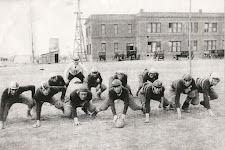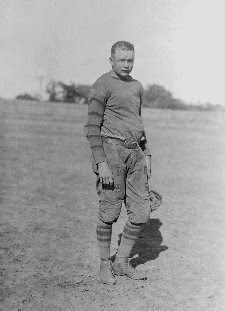 |
| The Rockin' S Cantina will be located on this lot just west of the Shell station in south Roscoe. |
At its last meeting, the City of Roscoe's Economic Development Board, also known as the A Board, approved a proposal to support a new liquor store projected to open in south Roscoe shortly before the annual Wind Festival in October.
The establishment, known as the Rockin’ S Cantina, will be run by Jason and Tarrah Stuart and will be located on the lot just west of the Chillerz Shell station on the access road to I-20 West.
It will be housed in a metal building with a drive-thru facing I-20 and will be a combination liquor store and gift shop. The Stuarts say they have already spoken to some local residents about providing homemade canned goods, art work, and other items for sale there.
They hope to create a hometown atmosphere and provide as many as five part-time jobs for local residents.
The establishment, known as the Rockin’ S Cantina, will be run by Jason and Tarrah Stuart and will be located on the lot just west of the Chillerz Shell station on the access road to I-20 West.
It will be housed in a metal building with a drive-thru facing I-20 and will be a combination liquor store and gift shop. The Stuarts say they have already spoken to some local residents about providing homemade canned goods, art work, and other items for sale there.
They hope to create a hometown atmosphere and provide as many as five part-time jobs for local residents.
--o--
ROSCOE INDEPENDENCE DAY CELEBRATION TO BE NEXT SATURDAY, JULY 7
 |
| Music for the street dance will be provided by country music star Curtis Potter. |
The Plowboy Mudbog will be only one of the attractions for Roscoe’s
annual Independence Day Celebration next Saturday. In addition, there
will be a parade down Broadway starting at 10:00am, street vendors on
Broadway and Cypress all afternoon and evening, live music and a street
dance on the stage between the Roscoe State Bank and Old Town Park—and,
of course, a spectacular fireworks show.
There will also be plenty of entertainment for the kids as there will be three kinds of bounce houses to keep them busy—one for ages 3-5, a larger one for ages 5-12, and yet another, a twenty-foot slide, for ages 12 and up.
This year’s live music will be provided by country music star Curtis Potter. More information about him can be found by clicking here.
Complete details about the celebration will be provided in next week’s Roscoe Hard Times—but make plans now to attend. You don’t want to miss it.
There will also be plenty of entertainment for the kids as there will be three kinds of bounce houses to keep them busy—one for ages 3-5, a larger one for ages 5-12, and yet another, a twenty-foot slide, for ages 12 and up.
This year’s live music will be provided by country music star Curtis Potter. More information about him can be found by clicking here.
Complete details about the celebration will be provided in next week’s Roscoe Hard Times—but make plans now to attend. You don’t want to miss it.
--o--
THIS YEAR’S PLOWBOY MUDBOG PROJECTED TO BE THE BEST YET
Organizers of this year’s Independence Day Plowboy Mudbog expect it to be the biggest and best yet as some of the most well known mud boggers in the region are planning to compete here.
This will include for the first time “Bug Nasty” and “Headhunter” from Hobbs, New Mexico, as well as contestants from Amarillo, Odessa, Ballinger, Colorado City, Roscoe, and elsewhere.
The mud track, just beyond right field of the baseball park, will be 200 feet long and go from two-feet deep to four-feet deep in good ol’ squishy Roscoe blackland mud. Winners are those that go the farthest before coming to a halt.
Entries will be in five classes:
1. Street: 35” tires and under with limited engine modification
2. Super Street: 35” with engine vac under 13”
3. Modified: 36” to 39” with limited engine modification
4. Super Modified: 36” to 39” with engine vac under 13”
5. Open: 40” and over.
Since there’s an advantage in going last rather than first, each truck takes two runs, with the second run in reverse order from the first.
The registration fee for entries is $30 with the winners of each class taking the fees as prize money.
Registration begins at 11:00am on Saturday in front of the baseball field at Second and Sycamore Streets. The public gate will open at 11:00am. Admission is $5 for adults and $2 for kids from 8 to 14. Children 7 and under are free. All proceeds go to benefit the Roscoe baseball little league and the Roscoe FFA.
For more information, contact Felix Pantoja at 325-514-8384 or David Pantoja at 325-280-1917.
--o--
A TRIP TO HAWAII AND MY DISCOVERY OF MESQUITE TREES THERE
 |
| This is the kind of view of Hawaii you'd expect to see, except that those trees out on the point are mesquites. |
For those of you who are interested, my trip to Hawaii was a nice break from the west Texas heat. One of my daughters was there house-sitting for a friend who was on a month-long vacation to Canada. I’d never been to Hawaii, so when she invited me out and told me her friend was happy to let me stay at her house, I felt that I should take advantage of the opportunity.
I spent my entire time there on the biggest island, Hawai’i, which is the size of Connecticut and Rhode Island combined. It has three major mountains on it, all volcanoes, many unusual sights, and miles and miles of beaches and shoreline. The island has a wet side and a dry side, and each has its own characteristics.
The wet side is lush and tropical with more weird and unusual plants than I’ve ever seen in one place. The dry side, which averages only ten to twenty inches of rainfall a year, is in some ways unique and in others surprisingly familiar for someone from west Texas.
My biggest surprise was in discovering that large parts of the dry side of the island are covered with—get this—mesquite trees! No, I am not making this up and am posting photographs to prove it.
One day my daughter said we should go to Kiholo Bay Beach, which is a great place for swimming and also where big wild sea turtles come to shore to sun on the rocks. The beach is public, but to keep it from being overrun by tourists, the locals purposely post no signs to it and have blocked off road access so that the only way to get to it is to park at an unmarked spot near the road and then hike down a mile or so through the woods—which is what we did.
On the hike down, I was struck by how much the landscape resembled west Texas—and how much the trees were like mesquites. Then I looked more closely at one and noticed that it had beans hanging from it as well as the characteristic mesquite leaves, thorns, and limbs. I then realized the whole countryside was covered with what were unmistakably mesquite trees and that the wild goats we encountered there are living on mesquite beans.
I was mystified by this discovery until later on when we did some research on the computer and found out that in 1828, a South American priest, Father Bachelot, the head of the first Catholic mission to Hawaii, planted a mesquite tree on the grounds of the mission, and all the mesquite trees in Hawaii have descended from that single original tree.
The priest introduced them to control soil erosion, but they quickly spread and are now a permanent fixture in the dry areas. In Hawaii they are called kiawe trees, and their wood is prized for barbecue, just like it is here. I tasted one of the mesquite beans, and they taste as you would expect but without the bitterness you find in the local mesquite beans.
My image of Hawaii will never be the same after discovering how common they are there.
Photos of my trip are available for viewing by clicking here.
--o--
WEATHER REPORT
I don’t know what it was like before Tuesday because I wasn’t here, but the temperatures have hit triple digits every day since then with Tuesday at 105°F, Wednesday at 106°, and yesterday about the same.
The forecast for today is for a high of 99° and tomorrow 98° with Sunday in the mid-nineties. There is no rain in the forecast.
--o--










That's some great information about the mesquite trees. I would have never thought such.
ReplyDelete